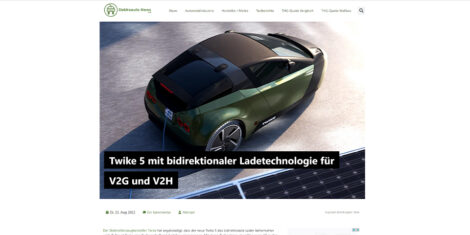elektroauto-news.net, 23.08.2022
Der Elektrofahrzeughersteller TWIKE hat angekündigt, dass das neue TWIKE 5 das bidirektionale Laden beherrschen wird. Dafür ist TWIKE eine Partnerschaft mit Ambibox eingegangen. Mit deren Technologie ist nicht nur ein AC-Laden mit 22 kW und eine DC-Schnellladefunktion über CCS möglich. Sie verfügt auch über einen direkten AC-Ausgang in Form einer im Fahrzeug integrierten CEE Steckdose mit 11 kW und einer Schuko-Steckdose mit 3,5 kW, um Energie aus der Antriebsbatterie des Fahrzeugs zurück in das Haus des Eigentümers oder für andere Verbraucher zu speisen.
Ambibox und TWIKE machen also nun aus den Schlagworten Vehicle to Grid (V2G) oder Vehicle to Home (V2H) Realität, beginnend mit der exklusiven Serie des TWIKE 5. Die Ambibox GmbH fungierte als Entwicklungspartner und integrierte deren bidirektionales DC-Ladegerät in die Fahrzeugarchitektur des TWIKE 5. Die SiC-basierte leistungselektronische Plattform von Ambibox kann so als hocheffizientes On-Board-Ladegerät genutzt werden.
„TWIKE-Piloten werden so zu Unternehmern im Bereich der erneuerbaren Energien und der Nachhaltigkeit. Sie benutzen ihr TWIKE wie ein Pfadfinder sein Schweizer Messer“, so das Unternehmen in einer aktuellen Mitteilung. Es sei absehbar gewesen, dass das neue TWIKE 5 zusätzlichen Kundennutzen bieten muss, indem es auch ein Energiespeichersystem für den eigenen Haushalt und damit auch das öffentliche Netz sein kann.
Neben TWIKE arbeiten auch andere Hersteller an V2G-Lösungen. Volkswagens Elektro-Baukasten MEB, auf denen alle Fahrzeuge der rein elektrischen ID-Familie aufbauen, beherrscht das bidirektionale Laden ebenfalls. Volkswagen testet bereits Versuchsfahrzeuge; im Laufe des Jahres 2022 soll jedes neue Elektroauto aus dem Konzern, das auf dem Modularen E-Antriebsbaukasten MEB basiert, Strom laden und auch wieder zurückgeben können.




Schreibe einen Kommentar